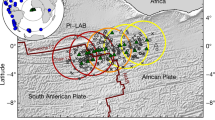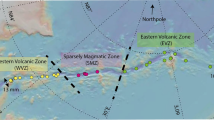Abstract
STUDIES1–7 of seamounts near the East Pacific Rise (EPR) have shown that, although most seamount lavas are petrographically and chemically identical to mid-ocean-ridge basalt, they are chemically and isotopically more diverse than those erupted on the rise axis. They are also generally more primitive (higher MgO content) and, in some cases, more depleted in incompatible elements than the axial basalts. This indicates that although near-ridge sea-mounts and the EPR share a common mantle source, there must be significant differences in their magma-supply processes. Sea-mounts are probably built by small batches of melt that rise rapidly to the surface, preserving evidence of heterogeneity in the mantle source region. By contrast, the processes of melting and melt segregation, storage and extrusion along the fast-spreading (9–13 cm yr–1) EPR are more efficient in mixing and homogenizing basalt compositions1–7. Here we show that the relationship of strontium, neodymium and lead isotope data between seamounts in the South Atlantic and the nearby axis of the slow-spreading Mid-Atlantic Ridge (MAR) is similar to that seen in the Pacific. This indicates that the processes leading to formation of near-ridge seamounts are similar at a wide range of spreading rates. Differences in the specific isotope signatures of lavas from near-ridge seamounts and axes of the EPR and MAR reflect regional differences in the upper-mantle source of mid-ocean-ridge basalts.
This is a preview of subscription content, access via your institution
Access options
Subscribe to this journal
Receive 51 print issues and online access
$199.00 per year
only $3.90 per issue
Buy this article
- Purchase on SpringerLink
- Instant access to full article PDF
Prices may be subject to local taxes which are calculated during checkout
Similar content being viewed by others
References
Batiza, R. & Vanko, D. J. geophys. Res. 26, 564–602 (1984).
Allan, J. F., Batiza, R. & Lonsdale, P. Seamounts, Islands, and Atolls, Geophys. Monogr. No. 43 (eds Keating, B. H. et al.) 255–282 (Am. geophys. Un., Washington, DC, 1987).
Allan, J. F., Batiza, R., Perfit, M. R., Fornari, D. J. & Sack, R. O. J. Petrol. (submitted).
Fornari, D. J., Perfit, M. R., Allan, J. F. & Batiza, R. Nature 331, 511–513 (1988).
Zindler, A., Studigel, H. & Batiza, R. Earth. planet. Sci. lett. 70, 175–195 (1984).
Fornari, D. J. et al. Earth planet Sci. Lett. 89, 63–83 (1988).
Graham, D. W. et al. Contr. Miner. Petr. 99, 446–463 (1988).
Batiza, R., Melson, W. G. & O'Hearn, T. Nature 335, 428–431 (1988).
Batiza, R. et al. J. Geol. 97, 209–220 (1989).
Hanan, B. B., Kingsley, R. H. & Schilling, J.-G. Nature 322, 137–144 (1986).
McKenzie, D. P. Earth planet. Sci. Lett. 74, 81–91 (1985).
Sleep, N. H. J. geophys. Res. 89, 10029–10041 (1984).
Castillo, P. Nature 336, 667–670 (1988).
Shirey, S., Bender, J. F. & Langmuir, C. H. Nature 325, 217–223 (1987).
Schilling, J.-G., Hanan, B. B. & McCully, B. Eos 69, 1426 (1988).
White, W. M., Hofmann, A. W. & Puchelt, H. J. geophys. Res. 92, 4881–4893 (1987).
Ito, E., White, W. M. & Gopel, C. Chem. Geol. 62, 157–176 (1987).
Schilling, J.-G. Earth planet. Sci. Lett. 25, 103–115 (1975).
Schilling, J.-G. Nature 314, 62–67 (1985).
Klein, E. M., Langmuir, C., Zindler, A., Staudigel, H. & Hamelin, B. Nature 333, 623–629 (1988).
Mahoney, J. J. et al. J. geophys. Res. 94, 4033–4052 (1989).
Castillo, P. Eos 69, 490 (1988).
Silver, P. G., Carlson, R. W. & Olson, P. A. A. Rev. Earth planet. Sci. 16, 477–541 (1988).
Dziewonski, A. M. J. geophys. Res. 89, 5929–5952 (1984).
Hager, B. H. J. geophys. Res. 89, 6003–6015 (1984).
Cazenave, A., Souriau, A. & Dominh, K. Nature 340, 54–57 (1989).
Cohen, R. S. & O'Nions, R. K. J. Petrol. 23, 299–239 (1982).
Allègre, C. J., Hamelin, B. & Dupre, B. Earth planet Sci. Lett. 71, 71–84 (1984).
Macdougal, J. D. & Lugmair, G. W. Earth planet Sci. Lett. 77, 273–284 (1986).
Catanzaro, E. J., Murphy, T. J., Shields, W. R. & Garner, E. L. J. Res. natn. Bur. Stand. 72A (1968).
Author information
Authors and Affiliations
Rights and permissions
About this article
Cite this article
Castillo, P., Batiza, R. Strontium, neodymium and lead isotope constraints on near-ridge seamount production beneath the South Atlantic. Nature 342, 262–265 (1989). https://doi.org/10.1038/342262a0
Issue date:
DOI: https://doi.org/10.1038/342262a0
This article is cited by
-
The involvement of deep plume-related materials in the South Atlantic Ocean asthenosphere as indicated by isotopic independent component analysis of basalts
International Journal of Earth Sciences (2023)
-
Extreme isotopic heterogeneity in Samoan clinopyroxenes constrains sediment recycling
Nature Communications (2021)
-
Geochemical and tectonic implications of igneous rocks from ODP leg 114, sub-antarctic South Atlantic
Geo-Marine Letters (1992)
-
Spreading rates, rift propagation, and fracture zone offset histories during the past 5 my on the Mid-Atlantic Ridge; 25°–27°30′ S and 31°–34°30′ S
Marine Geophysical Researches (1991)
-
Mixing of basalt magmas
Nature (1989)



